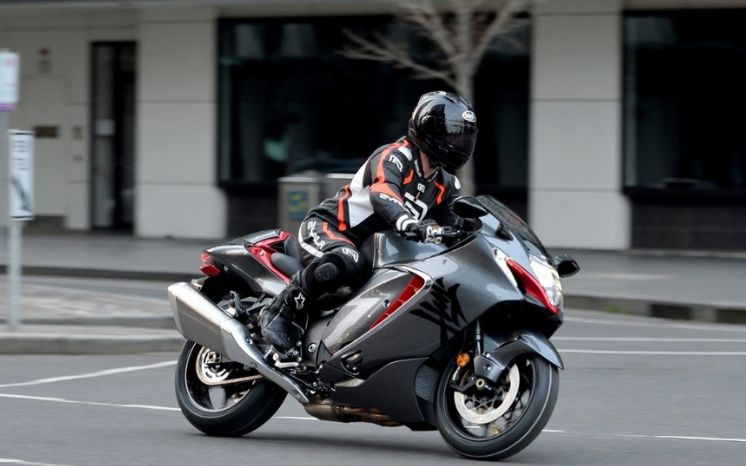Strapping a motorcycle helmet properly is a crucial aspect of safe riding. Ensuring a secure fit not only safeguards your head during a potential collision but also enhances comfort and stability while you ride. This guide is tailored to explain how to strap a motorcycle helmet effectively.
Understanding how to strap a motorcycle helmet correctly can mean the difference between life and death. It is not a mere accessory but an essential protective gear. This introductory guide aims to highlight the importance and procedure of strapping a helmet appropriately.
How To Strap A Motorcycle Helmet
Before we dive into the detailed steps, let’s understand why it is crucial to know how to strap a motorcycle helmet correctly. The foremost reason is safety. A secured helmet reduces the risk of severe head injuries and protects your brain from potential damage during an accident.
Moreover, strapping a helmet correctly also improves your riding experience. A snug-fit helmet minimizes any distractions while you ride, allowing you to concentrate on the road ahead. It also reduces wind noise and provides better stability at high speeds.
Now that we have established the significance of strapping a motorcycle helmet correctly let’s move on to the steps:
- Select a well-fitting helmet: Before strapping your helmet, ensure it fits your head correctly. A loose or tight helmet can be uncomfortable and may not provide adequate protection.
- Open the chin strap: Most helmets come with a chin strap that secures the helmet in place. Open the strap and adjust it to sit comfortably under your chin.
- Place the helmet on your head: Hold the helmet by its sides, keeping the front of the helmet facing you. Gently pull it down over your head, making sure it covers the entire head without any gaps.
- Fasten the chin strap: Once the helmet is on your head, fasten the chin strap and adjust it to fit snugly under your chin. Make sure you can breathe comfortably without the strap being too tight.
- Secure the D-ring closure: Some helmets come with a D-ring closure that needs to be secured after fastening the chin strap. This ensures extra security and prevents your helmet from coming off during an impact.
- Check for fit: After securing the helmet, move it around slightly to check if it is secure and stable on your head.
- Adjust as necessary: If the helmet feels too loose or tight, adjust the chin strap and D-ring closure if available. Ensure that the helmet does not move or slide around on your head.
- Double-check before every ride: Before you hit the road, always double-check for a snug fit and proper strapping of your motorcycle helmet.
In conclusion, strapping a motorcycle helmet correctly is vital for both safety and riding experience. By following these simple steps, you can ensure a secure and comfortable fit every time you ride.
See more: How To Stoppie Motorcycle
How to Ensure a Proper Fit

Ensuring a proper fit of your motorcycle helmet involves more than just strapping it correctly. A helmet that fits well will sit evenly on your head, not tilt back or roll forward, and not feel too tight or too loose.
To begin with, measure your head’s circumference at the widest part – typically just above your eyebrows and ears. This measurement will guide you in selecting the appropriate helmet size.
When trying a helmet, it should feel snug but not overly tight. You should not be able to move the helmet side to side or up and down easily when it’s strapped on.
Also, pay attention to any pressure points. These are areas where the helmet’s padding presses down too hard on your head. A helmet with significant pressure points can cause discomfort and headaches during long rides.
Remember, different brands and models might fit differently even if they’re marked the same size. Hence, it’s always beneficial to try on different helmets before finalizing your pick.
Lastly, keep in mind that helmet padding can compress over time, making the helmet looser. If this happens, it may be time to replace the helmet or the padding to ensure continued protection.
Following these pointers will help you achieve a motorcycle helmet fit that ensures both safety and comfort during your rides.
FAQs
When it comes to motorcycle helmets, riders often have several queries ranging from fit to maintenance. Here, we have compiled some frequently asked questions to provide further clarity on the subject.
How often should I replace my motorcycle helmet?
Motorcycle helmets should typically be replaced every five years, assuming no significant impacts or damage has occurred. The lifespan of a helmet can be influenced by a variety of factors such as how often it’s used, how it’s cared for, and exposure to the elements.
Regular use of a helmet can lead to the degradation of its materials, particularly the padding and retention system. Moreover, exposure to sunlight, sweat, and cosmetics can further accelerate the aging process. Always remember, if your helmet ever undergoes an impact, it should be replaced immediately even if there’s no visible damage.
Can I use a second-hand motorcycle helmet?
While it might be tempting to save some money by purchasing a second-hand helmet, it is not advisable. The reason is that you can’t be certain about its history. A helmet might seem undamaged from the outside, but it could have been dropped or involved in an accident, which can significantly compromise its protective capabilities. Also, the interior lining of a helmet, which absorbs sweat, can degrade over time, impacting both comfort and safety.
How can I clean and maintain my motorcycle helmet?
Keeping a helmet clean can significantly extend its life and maintain its protective qualities. Firstly, never use abrasive or chemical cleaners as they can damage the helmet’s materials. Instead, use mild soap and water to clean the exterior shell and visor.
For the interior, if it’s removable, hand wash it with the same mild soap and let it air dry. If the interior is non-removable, you can use a helmet cleaning spray. Regularly check the helmet for any signs of wear and tear, especially on the straps and clasps. Always store your helmet in a cool, dry place and avoid direct sunlight.
What should I do if my helmet strap is fraying?
If your helmet strap is fraying, it’s a sign that the helmet needs to be replaced. The chin strap is critical for keeping the helmet secured to your head during an impact, so its integrity is crucial. Don’t attempt to repair a fraying strap yourself as this can compromise the safety of the helmet. Always ensure that all parts of your helmet, including the strap, are in good condition before you ride.
Final Thought
As we explore the nuances of how to strap a motorcycle helmet, we must underline the gravity of its purpose. This humble piece of equipment holds the capacity to protect riders in dire circumstances, making its correct usage non-negotiable.
Precision in strapping, maintaining and replacing a helmet directly corresponds to the level of safety it provides. Therefore, investing time and effort in understanding these aspects can be lifesaving. Choosing the right helmet and ensuring it fits properly is the first step towards safer rides.
Moreover, regular maintenance of the helmet enhances its durability and performance. Cleaning it regularly and storing it properly preserves its protective features. It’s a simple act that can significantly extend the life of your helmet.
Lastly, always remember that no helmet, no matter how expensive or well-constructed, can offer complete protection if it’s not strapped correctly or if it’s past its expiration date. Adherence to the recommended guidelines is key to maximizing your helmet’s protective capabilities.
In conclusion, understanding how to strap a motorcycle helmet and ensuring its proper fit and maintenance is paramount to rider safety. It’s a small price to pay for the significant advantage it offers in preserving life and preventing serious injury.
